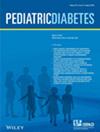青少年和年轻人报告的结果和使用连续血糖监测功能:来自CITY试验的报告
IF 3.9
3区 医学
Q2 ENDOCRINOLOGY & METABOLISM
引用次数: 0
摘要
目标。在青少年和青少年CGM干预(CITY)成人随机临床试验(RCT)中,评估连续血糖监测仪(CGM)使用模式和对1型糖尿病(T1D)青少年/年轻人使用CGM长达52周后的生活质量的感知。研究对象和方法。T1D患者最初以1:1的比例随机分配到使用CGM或血糖仪(BGM) 26周。随机对照试验结束后,BGM组开始CGM治疗(BGM - CGM队列),CGM组继续CGM治疗(CGM - CGM队列)26周。在基线、26周和52周完成糖尿病调查-儿科版(付费儿科版)、血糖监测满意度调查(GMSS)、低血糖置信量表(HCS)、糖尿病技术态度(DTA)、匹兹堡睡眠质量指数(PSQI)、CGM的益处和CGM的负担。结果。在这两个队列中,70%的参与者都穿着CGM服装。52周时每周5天;5%停用CGM。大多数人使用移动应用程序来接收血糖数据。青少年(14至19岁)比年轻人更有可能使用SHARE功能(80%对41%)。与基线相比,CGM-CGM参与者在52周时的GMSS、DTA和HCS得分显着提高,并且报告了比基线更高的获益和更低的负担感知。在BGM-CGM队列中也观察到类似的结果。结论。在使用CGM的青少年和年轻人中观察到自我报告测量的改善。由于CGM的使用也与更好的血糖控制有关,因此使用CGM可能有助于改善医疗结果和情绪健康。本文章由计算机程序翻译,如有差异,请以英文原文为准。
Adolescent- and Young Adult-Reported Outcomes and Use of Continuous Glucose Monitoring Features: A Report from the CITY Trial
Objective. To evaluate patterns of continuous glucose monitor (CGM) use and perceptions of quality of life in adolescents/young adults with type 1 diabetes (T1D) after using CGM for up to 52 weeks in the CGM Intervention in Teens and Young (CITY) Adults randomized clinical trial (RCT). Subjects and Methods. Participants with T1D were initially randomized 1 : 1 to use of CGM or blood glucose meter (BGM) for 26 weeks. Following the RCT, participants in the BGM group initiated CGM (BGM–CGM cohort) and participants in the CGM group continued CGM (CGM–CGM cohort) for another 26 weeks. Problem Areas in Diabetes Survey-Pediatric Version (PAID-peds), Glucose Monitoring Satisfaction Survey (GMSS), Hypoglycemia Confidence Scale (HCS), Diabetes Technology Attitudes (DTA), Pittsburgh Sleep Quality Index (PSQI), Benefits of CGM, and Burdens of CGM were completed at baseline, 26 and 52 weeks. Results. In both cohorts, >70% of participants were wearing CGM > 5 days/week at 52 weeks; 5% discontinued CGM. The majority used the mobile app to receive glucose data. Adolescents (14 to <19 years) were more likely to use SHARE features than young adults (80% versus 41%). CGM–CGM participants had significantly higher scores on GMSS, DTA, and HCS at 52 weeks compared with baseline, and reported higher benefit and lower burden perceptions than at baseline. Similar results were observed for the BGM–CGM cohort. Conclusions. Improvements in self-reported measures were observed in adolescents and young adults using CGM. As CGM use is also associated with better glycemic control, utilizing CGM may contribute to improving both medical outcomes and emotional health.
求助全文
通过发布文献求助,成功后即可免费获取论文全文。
去求助
来源期刊

Pediatric Diabetes
医学-内分泌学与代谢
CiteScore
6.60
自引率
14.70%
发文量
141
审稿时长
4-8 weeks
期刊介绍:
Pediatric Diabetes is a bi-monthly journal devoted to disseminating new knowledge relating to the epidemiology, etiology, pathogenesis, management, complications and prevention of diabetes in childhood and adolescence. The aim of the journal is to become the leading vehicle for international dissemination of research and practice relating to diabetes in youth. Papers are considered for publication based on the rigor of scientific approach, novelty, and importance for understanding mechanisms involved in the epidemiology and etiology of this disease, especially its molecular, biochemical and physiological aspects. Work relating to the clinical presentation, course, management and outcome of diabetes, including its physical and emotional sequelae, is considered. In vitro studies using animal or human tissues, whole animal and clinical studies in humans are also considered. The journal reviews full-length papers, preliminary communications with important new information, clinical reports, and reviews of major topics. Invited editorials, commentaries, and perspectives are a regular feature. The editors, based in the USA, Europe, and Australasia, maintain regular communications to assure rapid turnaround time of submitted manuscripts.
 求助内容:
求助内容: 应助结果提醒方式:
应助结果提醒方式:


